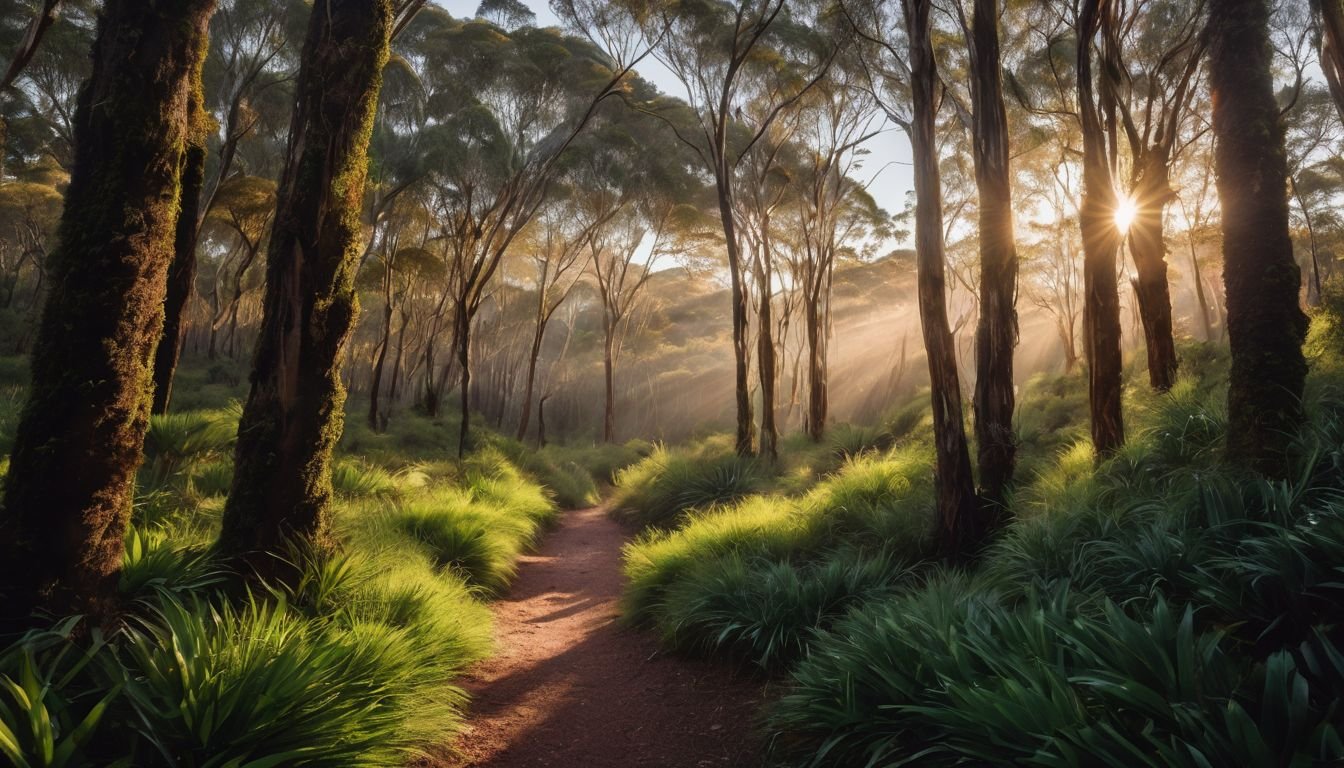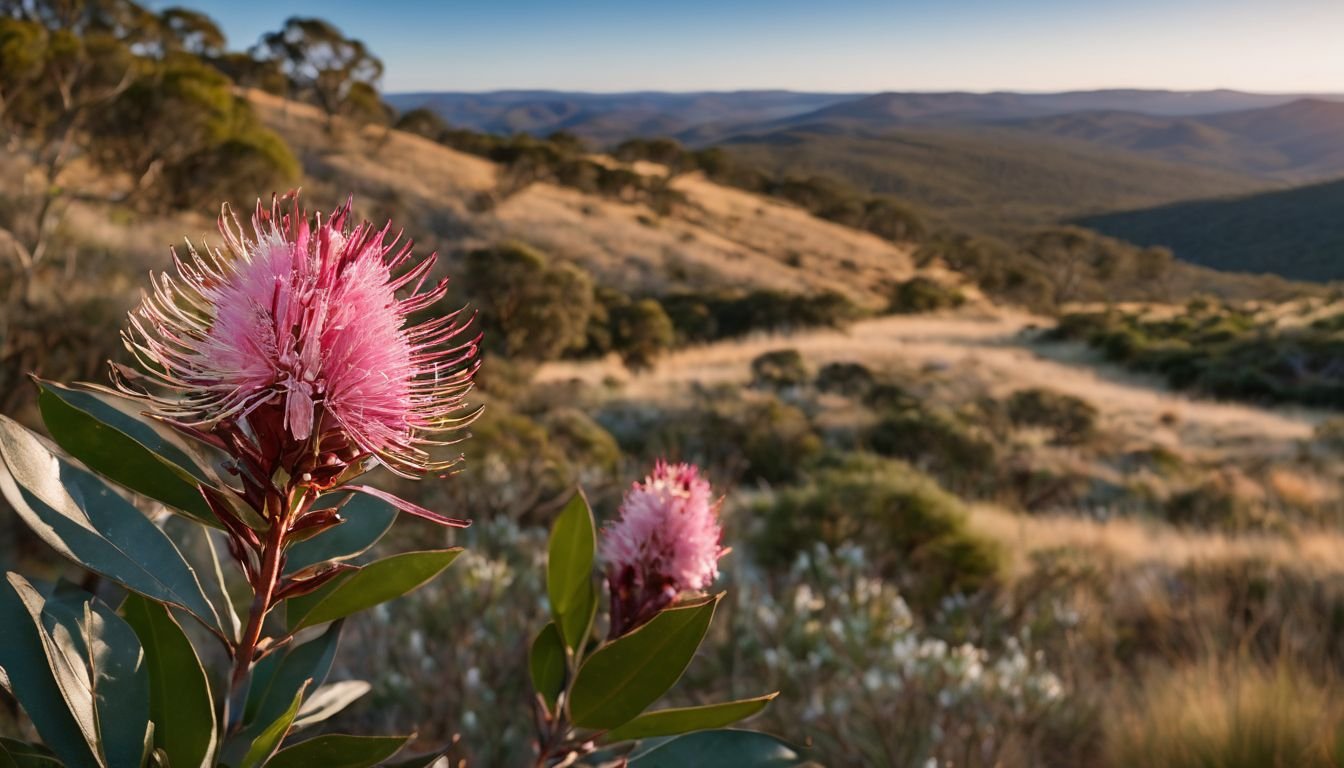Are you looking to add a touch of unique Australian beauty to your garden? Hakea laurina, known as the Pin-cushion Hakea, is an ornamental gem from southwest Australia that catches the eye with its striking blooms.
This blog will guide you through understanding this plant’s charm and how it could transform your outdoor space. Dive in to explore the allure of this Aussie wonder!
Key Takeaways
- Hakea Laurina, or Pin-cushion Hakea, is a striking native shrub from Southwest Australia that can grow up to 5 metres tall and flourishes in full sun and well-drained soil.
- This plant’s unique bluish-green foliage and distinctive red, pink, or white pompom-like flowers make it a dazzling addition to any garden and bloom from late summer to autumn.
- The Kodjet adapts well to various environments; it’s frost – tolerant, thrives in different soil types including sandy loam and heavy clay, and offers benefits like erosion control and habitat for wildlife.
- Hakea Laurina has cultural significance within the Noongar community of Southwest Australia where it’s known as Kodjet or Kojet, symbolising resilience and natural beauty.
- To keep your Hakea Laurina healthy, ensure good drainage to prevent root rot, provide ample sunlight, protect young plants from frost damage with cloth covers if needed, use fungicides sparingly for diseases like leaf fungus.
Overview of Hakea Laurina

Dive into the captivating world of Hakea Laurina, a botanical marvel from the diverse landscapes of Southwest Australia. This unique species not only adds aesthetic value to its native region but also thrives as a testament to the beauty and resilience inherent in Australian flora.
Description and Features
Hakea laurina stands out among garden plants with its striking appearance and resilience. Commonly known as the pincushion hakea, this species thrives in full sun and well-drained soil, showcasing its versatility in a variety of landscapes.
As a large shrub or small tree, it reaches up to 5 meters tall, presenting a bold silhouette against the sky.
The leaves of Hakea laurina are an impressive sight with their blue-green hue and prominent veining. Flower buds burst into life from late summer to late autumn, revealing intricate flower heads reminiscent of pincushions.
These inflorescences start as rich red bursts then fade to delicate pink or white hues, providing months of visual interest. The plant’s adaptability extends beyond soil preferences—it’s also frost tolerant, making it an outstanding choice for cooler climates where lesser plants might struggle.
In windy weather or calmer conditions alike, pincushion hakea holds its own with shallow roots gripping firmly into the earth.
Native and Endemic Status in Southwest Australia
Southwest Australia boasts a remarkable diversity of flora, and among its native treasures is the Hakea Laurina. This striking plant stands out in the region’s bushland, not just for its beauty but also as an example of an endemic species, flourishing solely within this unique geographical area.
Its deep roots in Western Australia speak to millennia of evolution, shaped by the challenging climate and soil conditions that define this part of the world.
Plant enthusiasts will appreciate knowing that every kodjet they encounter in Southwest Australia has grown from local origins. The distribution of these plants remains tightly bound to their native soils—unlike many species that gardeners transplant worldwide.
Their strong connection with their home territory makes them essential pieces in Southwest Australia’s ecological puzzle, functioning as both beautiful additions to sunny spots on lawns and critical components supporting regional biodiversity.
Unique Attributes of Hakea Laurina

The Hakea Laurina stands out in the diverse flora of Southwest Australia, thanks to its distinctive characteristics that not only contribute to its beauty but also demonstrate a remarkable resilience.
These features have carved a niche for this native species, making it an essential component of both natural habitats and urban landscapes.
Bluish Foliage and Pompom Flowers
Hakea Laurina turns heads with its striking bluish foliage. This unique colour sets it apart in any garden, giving off a cool and calming effect. Picture the leaves arranged alternately along the branches, their blue tinge contrasting against other greens in your outdoor space.
Pompom flowers burst from the axil of each leaf during the blooming season, creating a festive display of white, deep pink, or red balls that resemble cheerleader pom-poms at a football match.
These vibrant blossoms not only add splashes of bold colour but also symbolise nobility and longevity—making Hakea Laurina a meaningful addition to any landscape. Plant enthusiasts admire these globular inflorescences for their beauty and the sense of life they bring to both public street tree settings and private backyards.
Adaptability to Various Environments
The striking bluish foliage and pompom flowers of Hakea Laurina pave the way for its remarkable ability to thrive in diverse conditions. This resilience makes it a favorite among gardeners and conservationists alike.
Its roots run deep into all sorts of soil, proving that whether it’s sandy loam or heavy clay, this plant stands firm. Garden enthusiasts will find joy in the fact that no special potting mix is needed for cultivation, as Hakea Laurina adapts with ease.
Tough frosts are no match for its sturdy nature; even when temperatures plunge, the Kodjet continues to flourish. In urban landscapes where eucalyptus trees might falter, this versatile species serves as an elegant ornament and provides much-needed shade on public streets.
More than just decorative, it creates havens for wildlife, breaks harsh winds, and holds soil steadfastly against erosion—a true guardian of both beauty and function within our environment.
Cultural Significance of Hakea Laurina
4. Cultural Significance of Hakea Laurina:.
Deeply rooted in the heritage of Southwest Australia, Hakea Laurina stands as a symbol of resilience and natural beauty in Noongar culture, where it’s known by its indigenous names Kodjet or Kojet.
Its widespread presence as an ornamental species extends beyond Australian borders, gracing international streetscapes and gardens with its unique aesthetics.
Noongar Name: Kodjet or Kojet
The Hakea Laurina holds a special place in the heritage of Australia’s Indigenous Noongar people, known by its traditional names Kodjet or Kojet. This name is more than just a label; it represents an intimate connection spanning countless generations, as these communities have lived alongside and cared for the diverse flora in their native Southwest Australian environment.
Incorporating this plant into your garden does more than add visual appeal; using its Noongar name can become a nod to the rich cultural tapestry that has cherished it throughout history.
As you care for your own Kodjet, you’re not only nurturing a beautiful plant but also honouring an ancient tradition and keeping alive the wisdom embedded in its original name.
Use as a Street Tree and Hedge in Various Countries
Hakea Laurina stands out as a popular choice for street planting and hedging in countries like Italy and America. Its adaptability to various soil types, combined with frost tolerance, makes it an ideal option for urban environments where resilience is key.
Gardens across these nations feature Hakea Laurina not just for its environmental suitability but also for the aesthetic appeal of its bluish foliage and unique pompom flowers.
Many suburban areas have embraced this versatile plant as a feature tree or informal hedge, contributing to vibrant green spaces that enhance neighborhood ambience. Its ability to thrive in different settings has led to widespread cultivation both within Australia and internationally, showcasing this native species’ global gardening appeal.
Common Problems and Solutions for Growing Hakea Laurina
Hakea Laurina adds a stunning touch to any garden, but like all plants, it faces its own set of challenges. Understanding and tackling these issues will ensure your Hakea thrives.
- Root-rot fungus is a key issue for Hakea Laurina, which can cause branches to die back. This problem often arises in soil that doesn’t drain well. To prevent this, plant the Hakea in light, well-draining soil and avoid over-watering.
- Spotting signs of distress early can save your plant. If you notice wilting or discoloured leaves, reduce watering and allow the soil to dry out more between sessions.
- Fungal diseases strike when air circulation is poor. Ensure your Hakea isn’t crowded by other plants and prune regularly to promote good airflow.
- Pests such as aphids and scale insects might target your plant. Use eco – friendly insecticidal soap or neem oil spray to keep these critters at bay without harming beneficial insects.
- Sometimes yellowing leaves may occur due to nutrient deficiencies. Amend the soil with a slow – release fertiliser rich in iron and magnesium to keep leaves green and healthy.
- Sunlight is essential for Hakea Laurina’s growth; inadequate light leads to weak stems. Plant your Hakea where it will receive full sunlight for the majority of the day.
- In very cold climates, frost can be harmful. Protect young plants with a frost cloth during chilly nights until they’re more established and resistant.
Conclusion
Embrace the chance to include Hakea Laurina in your garden treasures. Let its unique pompom flowers and bluish foliage enliven your outdoor space. Remember, this Southwest Australian native not only adds aesthetic appeal but also carries a legacy of nobility and resilience.
Tending to it offers both joyous rewards and a touch of exquisiteness far from its native soil. Transform your green sanctuary with the remarkable beauty of this distinctive plant.
FAQs
1. What is special about the Hakea Laurina plant?
The Hakea Laurina, known as Pincushion Hakea, is renowned for its unique red and cream pin-cushion like flowers that attract birds and bees.
2. Can I grow Hakea Laurina in my garden?
Yes, you can cultivate Hakea Laurina in your own garden as it’s adaptable to a variety of soil types and climates.
3. When does the Hakea Laurina flower?
Hakea Laurina typically bursts into bloom during late autumn to early winter.
4. Is the Hakea Laurina suitable for small gardens?
Given its moderate size upon maturity, the Hakea Laurina can fit well into smaller gardens if given enough space to flourish.
5. How should I care for a newly planted Hakea Laurina?
Water your new Hakea Laurina regularly until established and ensure it gets full sun or partial shade for optimal growth.
